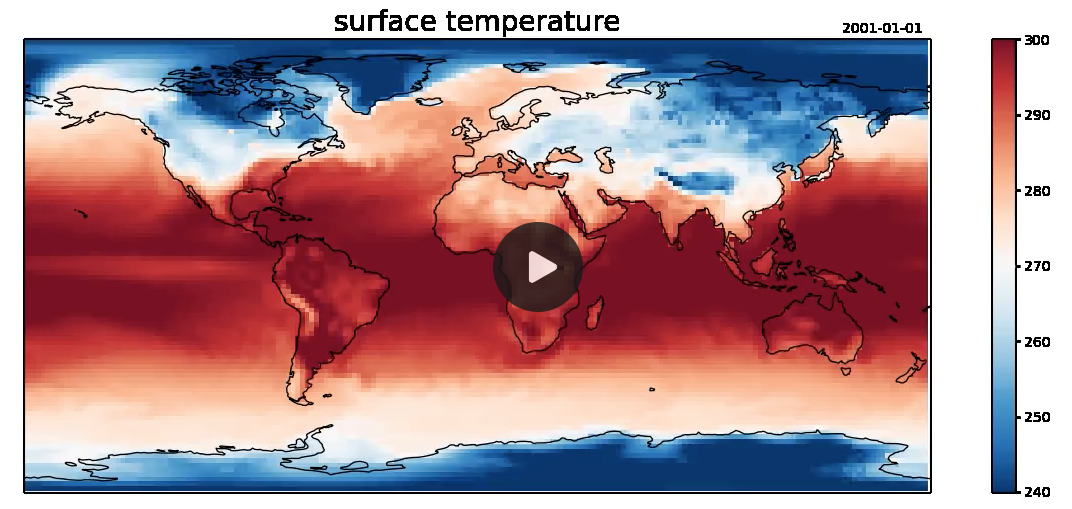Python animation with ffmpeg#
Software requirements:
Python 3
numpy
xarray
matplotlib
cartopy
ffmpeg
Example script#
animation_with_ffmpeg_normal_and_faster.py
#!/usr/bin/env python
# coding: utf-8
'''
DKRZ tutorial
Animation of geospatial data
It is quite easy to create a video with Matplotlib and FFmpeg from time-
dependent data. In this notebook the deployment of the temperature data over
time is shown using two slightly different ways, which differ significantly
in runtime.
Note:
In case of problems with FFmpeg it is advisable to install the latest
version and set the ffmpeg_path via plt.rcParams to animation.ffmpeg_path
as already used in this notebook.
Content
- Create the animation as usual (run time: 16.4s)
- Create the animation 8x faster (run time: 1.9s)
- save the animation in mpeg4 file
The example input file _rectilinear_grid_2D.nc_ can be downloaded from
https://nextcloud.dkrz.de/s/WHGZgCWrZLPnpBn
FFmpeg home page: https://ffmpeg.org/
-------------------------------------------------------------------------------
2022 copyright DKRZ licensed under CC BY-NC-SA 4.0
(https://creativecommons.org/licenses/by-nc-sa/4.0/deed.en)
-------------------------------------------------------------------------------
'''
import time, os
import numpy as np
import xarray as xr
import matplotlib.pyplot as plt
from matplotlib.animation import FuncAnimation
from matplotlib import animation
import cartopy.crs as ccrs
def main():
# Set the path of the ffmpeg binary, e.g. in a 'cartopy' conda environment
ffmpeg_path = os.environ['HOME']+'/miniconda3/envs/cartopy/bin/ffmpeg'
plt.rcParams['animation.ffmpeg_path'] = ffmpeg_path
# Open data set
infile = '../../data/rectilinear_grid_2D.nc'
ds = xr.open_dataset(infile)
# Read the data and coordinate variables.
lon = ds.lon
lat = ds.lat
var = ds.tsurf
# Set plotting parameters
# -----------------------
# Use the dictionary `plot_parameter` to define some plot settings.
plot_parameter = {}
plot_parameter['extent'] = [-180, 180, -90, 90]
plot_parameter['projection'] = ccrs.PlateCarree()
plot_parameter['vmin'] = 240.
plot_parameter['vmax'] = 300.
plot_parameter['cmap'] = 'RdBu_r'
plot_parameter['title'] = var.long_name
# Get number of frames
# --------------------
# The input dataset contains 40 time steps and we want to create the animation
# over all.
frames = ds.time.size
# Get date strings
# ----------------
# The date string should be added on top of the plot and therefore we get the
# date strings in a nicer notation.
time_str = ds.time.dt.strftime('%Y-%m-%d').data
#------------------------------------------------------------------------------
# Define function plot_init()
#
# This function is needed as input for the `init_func` parameter of
# Matplotlib's `FuncAnimation`. It presets in this case the extent of the
# map, the title and coastline drawing.
#------------------------------------------------------------------------------
def plot_init():
ax.set_extent(plot_parameter['extent'])
ax.coastlines()
plt.title(plot_parameter['title'], fontsize=20)
return plot
#------------------------------------------------------------------------------
# Create the animation as usual
# -----------------------------
# We use Matplotlib's `FuncAnimation` routine to make an animation from the
# time-dependent variable _surface temperature_. `FuncAnimation` needs as
# second input parameter a _function to call at each frame_. In this case we
# define the function `update_frame()` for creating a plot for a given
# timestep (frame).
#------------------------------------------------------------------------------
# Define function update_frame()
#
# This is the function that is called for each time step (frame) to generate
# the corresponding plot.
#------------------------------------------------------------------------------
def update_frame(frame):
plot = ax.pcolormesh(lon, lat, var[frame,:,:],
cmap=plot_parameter['cmap'],
vmin=plot_parameter['vmin'],
vmax=plot_parameter['vmax'])
tx.set_text(time_str[frame])
return plot, tx
# Create the animation I
# ----------------------
# Now, we can generate the animation doing the following steps:
#
# 1. define figure and axis
# 2. create the plot object for the first time step
# 3. add a colorbar
# 4. add the date string on top
# 5. create the animation in memory
# 6. save the animation to a mpeg4 file
t1 = time.time()
fig, ax = plt.subplots(figsize=(16,6),
subplot_kw={"projection": plot_parameter['projection']})
plot = ax.pcolormesh(lon, lat, var[0,:,:],
cmap=plot_parameter['cmap'],
vmin=plot_parameter['vmin'],
vmax=plot_parameter['vmax'])
cb = plt.colorbar(plot)
tx = fig.text(0.69, 0.89, time_str[0])
ani = FuncAnimation(fig, update_frame, frames=range(0, frames),
init_func=plot_init)
ani.save('tsurf_animation.mp4',
writer=animation.FFMpegWriter(fps=60, bitrate=5000, codec='h264'),
dpi=100)
t2 = time.time()
print('run time: '+str(t2-t1))
#------------------------------------------------------------------------------
# Create the animation 8x faster
# ------------------------------
# Instead of creating a new plot for each time step, we only exchange the
# data array for the plot in the `update_frame2()` function with Matplotlib's
# `plot.set_array()` method. This makes the creation of the animation much
# faster.
#------------------------------------------------------------------------------
# Define function update_frame2()
#
# Exchange the data array of the plot with Matplotlib's `plot.set_array()`
# method. This makes the creation of the animation much faster.
#------------------------------------------------------------------------------
def update_frame2(frame):
plot.set_array(np.array(var[frame,:,:]).ravel())
tx.set_text(time_str[frame])
return plot, tx
# Create the animation II
# -----------------------
# Same as above but this time we use the `update_frame2()` function to create
# the animation with Matplotlib's `FuncAnimation`.
#
# 1. define figure and axis
# 2. create the plot object for the first time step
# 3. add a colorbar
# 4. add the date string on top
# 5. create the animation in memory
# 6. save the animation to a mpeg4 file
t1 = time.time()
fig, ax = plt.subplots(figsize=(16,6),
subplot_kw={"projection": plot_parameter['projection']})
plot = ax.pcolormesh(lon, lat, var[0,:,:],
cmap=plot_parameter['cmap'],
vmin=plot_parameter['vmin'],
vmax=plot_parameter['vmax'])
cb = plt.colorbar(plot)
tx = fig.text(0.69, 0.89, time_str[0])
ani = FuncAnimation(fig, update_frame2, frames=range(0, frames),
init_func=plot_init)
ani.save('tsurf_animation.mp4',
writer=animation.FFMpegWriter(fps=60, bitrate=5000, codec='h264'),
dpi=100)
t2 = time.time()
print('run time: '+str(t2-t1))
if __name__ == '__main__':
main()
